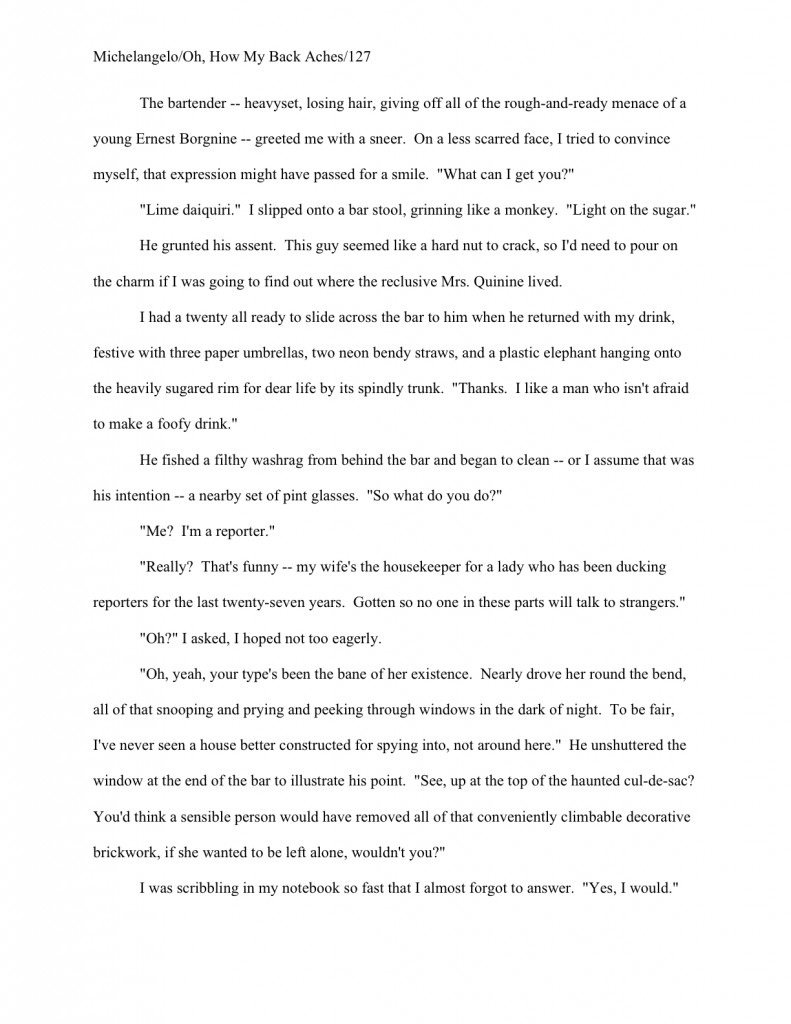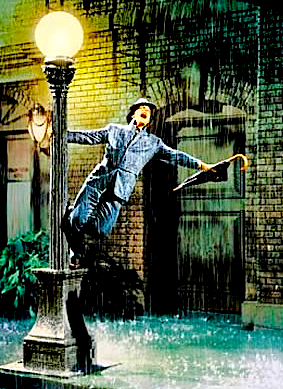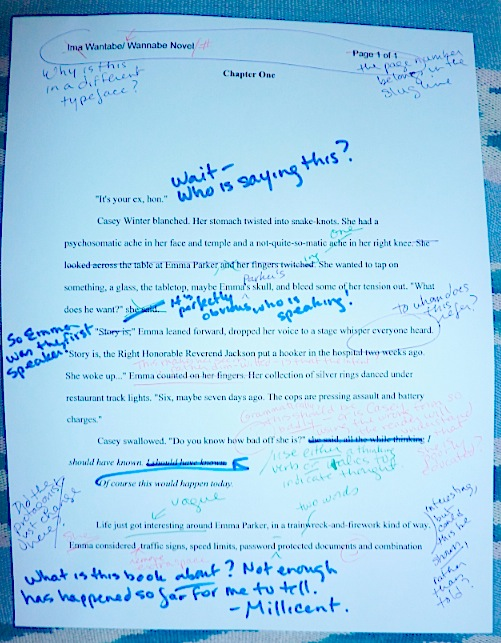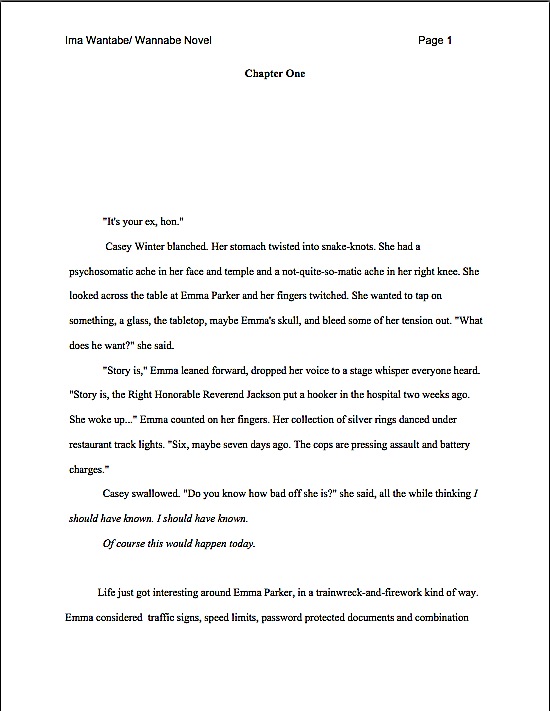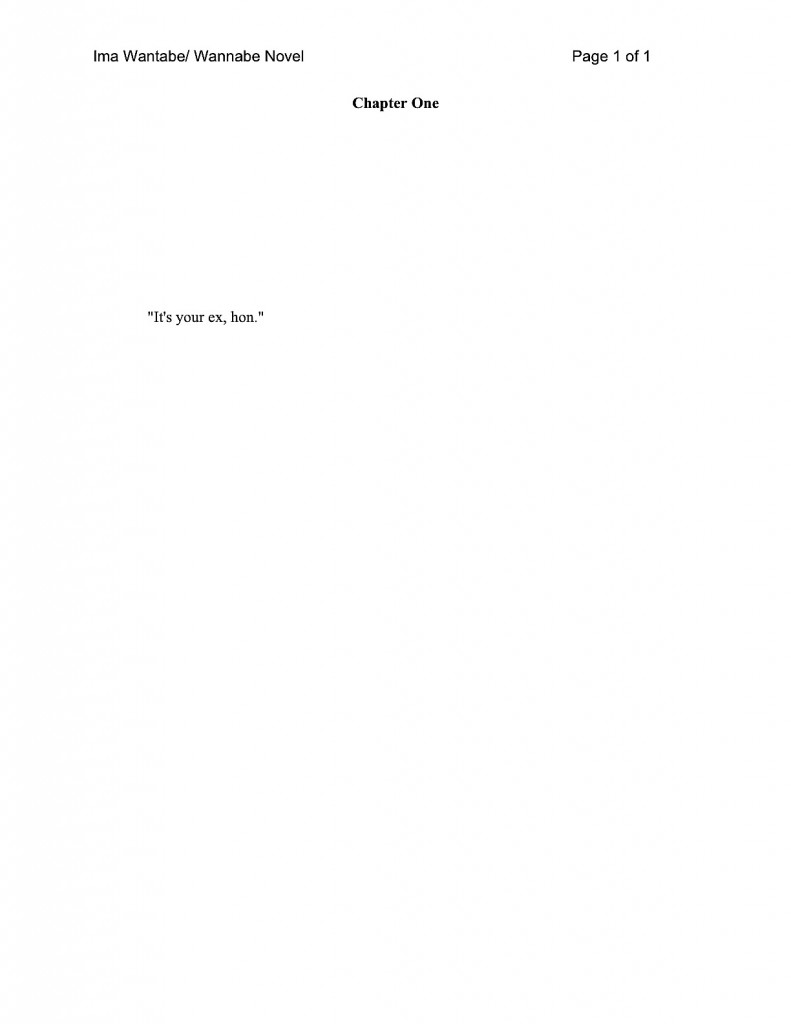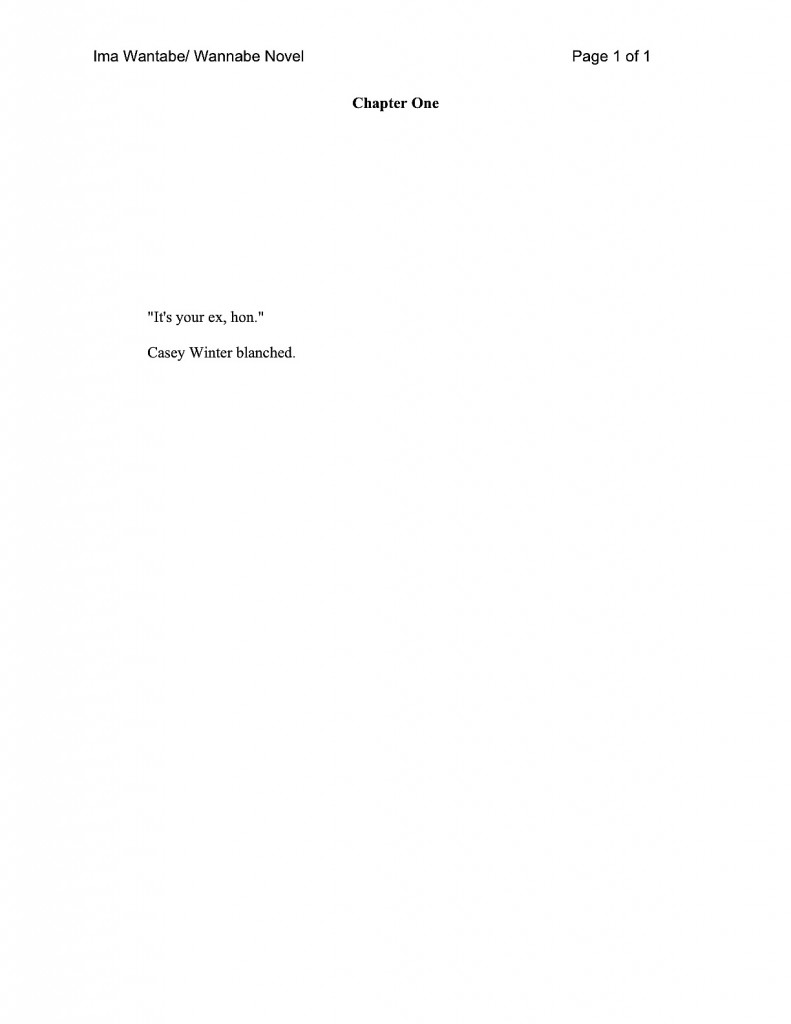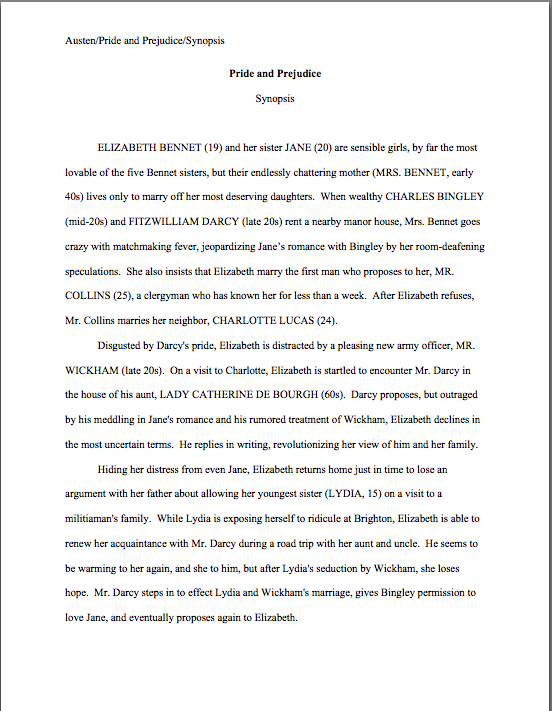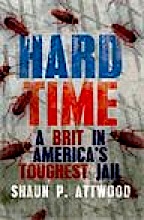Yes, yes, I know — it’s been a while since I’ve posted, although I have been consistently answering the ever-burgeoning crop of readers’ questions that have been cropping up on archival posts. (Word to the wise: since writers habitually ask such good questions, reading the comments on those posts is often quite worthwhile.) It’s been an even longer while that we’ve been meandering toward the end of this series on the steps and missteps pitchers and queriers take immediately after having pulled off their ostensible goal: to provoke an agent or editor to request manuscript pages.
Yes, I did say ostensible, because you’d be astonished at how frequently successful pitching or querying induces not only the kind of oh-my-God-I-have-to-get-this-out-the-door-instantly! panic we have discussed so much throughout this series, but an actual feeling of letdown. All too often, after expending the intense effort and socially underestimated bravery of presenting one’s baby to someone actually in a position to get it published, the would-be submitter finds herself beginning to doubt whether that yes really did mean yes — or whether it was an enthusiastic enough yes to be regarded as a good sign.
Or even sufficient reason to comply with the request for pages. Over half of requested materials never arrive, after all.
I’m delighted to hear most of you guffawing merrily. “Oh, come on, Anne,” those of you who have yet to be in this seemingly enviable position scoff, “how insecure would a successful pitcher or querier have to be to experience qualms at that juncture? I can understand experiencing some icy tootsies at earlier points — while working up the immense guts required to pitch a book to a real, live agent, for instance, or in that awful pause between receiving a rejection and sending out the query again. But why in heaven’s name would a sensible, sensitive, intelligent writer feel let down by learning that his pitch or query worked? Or not act upon it when it did?”
Several reasons, in practice. First, pitchers and queriers sometimes harbor false hopes for what they can achieve with an initial approach. One of the most pernicious myths of publishing is that if a writer is really talented, her book will attract serious attention from the industry at first glance, rather than the result of years of persistence. So even if a writer knows intellectually that the best possible outcome at the pitching/querying stage is, in fact, for the pro to ask to see pages, she may still feel disappointed that the agent of her dream’s first response is, “Your premise seems interesting; I’d like to see how you handle it on the page,” rather than “By Jove, that’s the best book concept I’ve ever heard! No need to read any of your actual writing — I’m going to sign you here and now!”
Of course, the latter response had ever actually emerged from an agent or editor’s lips when speaking to a non-celebrity writer’s pitch or query, it would be a bit insulting, right? How could anyone tell whether a book is well-written without reading it — or judge a writer’s potential without bothering to clap eyes upon what he has written? Indeed, what agent or editor in her right mind would even consider signing a writer whose work she’s never read?
But ‘fess up, pitchers and queriers: at least at first, you walked into the process hoping that she would, didn’t you?
Another reason writers suddenly finding themselves on the receiving end of a request for pages sometimes feel low is that it can take a lot of nos to get to yes. Yes, no matter how talented one might happen to be: typically, it takes a writer new to the game a while to figure out which agents to approach, let alone how to approach them professionally. Yet due no doubt to that aforementioned pernicious myth that true talent always finds a home, and instantly, many, if not most, aspiring writers presume that any rejection means that they’re not talented enough to get published.
As a direct a simply staggering percentage of queriers, pitchers, and even submitters make the attempt only once. “I tried!” they protest. “But the publishing world didn’t want my work. So why should I try again?”
Um, because agents and editors are individuals, not merely cogs in a vast collective publishing mind? Logically, no single rejection could possibly equal rejection by the entire industry.
To be fair, though, that’s a heck of a lot easier to say than to believe. Rejection hurts; there’s just no way around that. And if one’s work gets rejected enough, the anticipation of further rejection can render even an awfully gosh darned enthusiastic request for pages seem like a spider’s coyly inviting a trusting fly over for a dinner and a movie.
And then there’s the most common reason that successful queriers and pitchers feel less than thrilled by the advent of a cordial request to send pages: they don’t know how to respond. It’s not that they don’t want to take advantage of the opportunity; they’re simply unsure how to do it. What if they inadvertently do something wrong?
Thus this series, in case you had been wondering. No matter how eager you are to get published, it can be genuinely stressful to be asked to submit your work. Especially if you happen to have bought into that pernicious myth, and believe that the process should be easy and quick.
I can tell you now that it won’t be — and that the length and curviness of a writer’s road to publication is a notoriously poor predictor of authorial success. What’s a better predictor, in my experience? A writer’s persistence — and her willingness to take the time to learn how publishing actually works, rather than stubbornly clinging to any myths on the subject that she might have picked up along the way.
Or, to put it another way: while the publishing world does not always reward writers serious enough to professionalize their outlooks, it has a long and glorious history of preferring those that do.
Which is one aspect of how the publishing industry treats writers that I really like, actually: collectively, it tends to assume not only that anyone who can write well enough to deserve to be published is an intelligent human being, but also that a good writer can and will learn the ropes of the business side of publishing prior to expecting to make a living within it. Just as no rational being would walk into an operating theatre and begin performing brain surgery with no previous training or basic knowledge of human anatomy, the logic runs, what smart aspiring writer would believe that successfully pulling off one of the most complex achievements of the human psyche, the writing of a truly good book, requires no advance practice? Or that the industry devoted to bringing those magnificent expressions of the human spirit to public attention has no internal rules or standards to which someone brand-new to the biz would be expected to adhere?
In this era where even news shows operate on the assumption that the average adult has the attention span of a three-year-old — and one who has been stuffing candy into his eager mouth for the last two hours at that — I find agents’ and editors’ presumption of authorial intelligence rather refreshing. If a trifle optimistic in practice.
How so? Well, many successful queriers and pitchers see only the negative fallout of this industry-wide assumption: since the pros expect writers to do their own research before trying to get their books published, rookie submitters are often stunned that nobody in the industry just tells them what to do. Wasn’t this supposed to be easy and straightforward, as the pernicious myth led us to believe? From a first-time querier’s perspective, it can seem downright counterproductive that agents just expect him to know what a query letter should look like, what information it should contain, and that it shouldn’t just read like a back jacket blurb for the book.
Heck, how is someone who has never met an agented author in person to know not just to pick up the phone and call the agent in question? Magic? Osmosis?
Similarly, agents, editors, and contest judges presume that anyone genuinely serious about her writing will have learned how professional writers format their manuscripts — an interesting presumption, given that many, if not most, aspiring writers are not aware that professional manuscripts are not supposed to resemble published books.
Correct me if I’m wrong, but that’s not information that the average writer is born knowing — which is a real shame, since professionally-formatted manuscripts tend to be taken far more seriously at submission time than those that are not.
Again: thus this series — and thus the HOW TO FORMAT A BOOK MANUSCRIPT category on the archive list at right. Chant it with me now, those of you who have been following this series closely: people who read manuscripts for a living assume that since good writers are intelligent people, the only reason that a manuscript would not be formatted properly is that the submitter did not bother to do his homework.
In other words, from their perspective, a query or submission that does not conform to their expectations of what is publishable (in terms of writing) or marketable (in terms of content or authorial authority) indicates that the writer just isn’t ready yet to play in the big leagues. He may not be waiting for the Manuscript Fairy to wave her wand over his just-completed first draft, causing an agent — any agent, for what does it matter? — to appear on his doorstep, clamoring to represent writing she hasn’t read, but he isn’t exactly investing the time in learning how professional writing looks, either.
That doesn’t necessarily mean, of course, that the writer question will never produce professional-level work; indeed, folks in the industry tend to assume (and even say at conferences) that they’re confident that if a truly talented writer gets rejected, she will take it as a sign that she needs to improve her presentation. Since the information on how to do that is available — on this website, as a matter of fact — why wouldn’t someone with a genuine gift invest the time and effort in learning to do it right?
In my experience, there’s a very straightforward answer to that: because the average querier or submitter, gifted or otherwise, doesn’t have a clear idea of what he’s doing wrong — or that there is a professional standard to which he should be adhering. And since most rejection letters these days contain absolutely no clue as to what caused the agent (or, more commonly, the agent’s screener) to shove the submission back into the SASE — heck, some agencies no longer respond at all if the answer is no — I don’t find it all that surprising that the aspiring writer’s learning curve is usually quite steep.
That’s why, should you have been speculating on the subject for the last few paragraphs, I am bringing up the expectation of intelligent research at the end of this series on how to respond to a submission request. Indeed, it’s a large part of the reason that I write this blog: from an outside perspective, it’s just too easy to interpret the sometimes esoteric and confusing rules of querying, pitching, and submission as essentially hostile to aspiring writers — and thus as justification for hesitating when faced with a request for pages.
Yes, the hoops through which a new writer needs to jump in order to get his work considered by the pros are many, varied, and sometimes flaming, but that’s not due to any antipathy toward rookies. Honestly, the hoops exist mostly for practical reasons. While many of the querying and submission restrictions have indeed been established in order to narrow the field of candidates for the very, very few new client slots available at most agencies, the intent behind that weeding-down effort is not to discourage talented-but-inexperienced writers from trying to get their work published. The underlying belief is that an intelligent person’s response to rejection will not be to give up, but to analyze what went wrong, do some research about what can go right, and try, try again.
That’s right: the fine folks who toil in agencies and publishing houses don’t expect the writers they reject to disappear permanently, at least not the ones with genuine talent. They believe that the gifted ones will return, this time better equipped for life as a professional writer.
To cite the old publishing industry truism, good writing will always find a home. What the agents and editors who spout this aphorism seldom think to add is: but not necessarily right away. Like learning any other set of job skills, becoming a professional writer can take some time. And one heck of a lot of effort.
Which means, from the business side of the industry’s perspective, writers who give up after just a few rejections — which, as I mentioned, is the norm, not the exception — are those who aren’t genuinely interested in making the rather broad leap between a talented person who likes to write and a professional writer in it for the long haul. Trust me, Millicent the agency screener doesn’t waste too many tears over the loss of the former.
I don’t see it that way, personally: I see the crushed dreams. But that doesn’t mean that I don’t think that most talented aspiring writers take individual rejections far, far too seriously.
As I said, this is a field of endeavor that not only rewards, but assumes persistence in a writer. Yet in recent years, it seems as though every third aspiring writer I meet has either:
(a) sent out a single query, got rejected, and never tried again,
(b) had a few queries rejected two years ago, and has been feverishly revising the manuscript ever since, despite the fact that no agent had yet seen it,
(c) pitched successfully at a conference, but convinced herself that the only reason four agents asked to see her first chapter was because those agents were too nice not to say yes to everybody,
(d) received a positive response to a query or pitch, then talked himself out of sending the requested materials at all, because his work isn’t good enough — how could it be, when he’s been rejected in that past?
(e) sent out the requested pages, but in order to save herself from disappointment, decided in advance that none of the replies will be positive,
(f) received the first manuscript rejection — and expanded it mentally into a resounding NO! from everyone in the industry, and/or
(g) concluded from conference chatter that no one in the industry is interested in any book that isn’t an obvious bestseller. Why bother to try to break into a biz that doesn’t want new voices?
In short, each of these writers had decided that his or her fears about what happened must have been true, rather than doing the research to find out whether the explanation hurt feelings dictated was in fact the most reasonable one, or even remotely plausible. To address some of the more common leapt-to assumptions, in the order they appeared above:
(a) a single query is not — and cannot, by definition — be indicative of how every agent on earth will react.
A better response: why not try again?(b) until agents have actually seen the manuscript, there’s no way a writer can know how they will respond to it.
A better response: work on improving the query.(c) no, the agents and editors weren’t asking everyone to send pages — pitching just doesn’t work that way.
A better response: if your pitch or query garnered a submission request, assume that you did something right and send out the materials.(d) how do you know for sure until you send it out?
A better response: learn how to present your work professionally, then submit it.(e) in my experience, foretelling doom does not soften future misfortune, if it comes — it only serves to stultify present hope.
A better response: hedge your bets by continuing to query other agents while waiting to hear back from the first round.(f) any agent or editor’s opinion of a book is just that, an opinion.
A better response: see (a)(g) contrary to pernicious myth, the publishing industry makes most of its money on books that are neither bestsellers nor small-run books. Most of the time, the mid-list titles are paying the agency’s mortgage.
A better response: take the time to learn how the industry works, rather than killing your chances entirely by not continuing to try.
None of this is to say that bouncing back from rejection is easy, of course, or that landing an agent is a snap. The road from first idea to publication is long and bumpy, and seems to get bumpier all the time.
Honestly, though, is the pain of rejection worse than the strain of not pursing your dream? As Maya Angelou tells us, “There is no greater agony than bearing an untold story inside of you.”
Yes, it’s emotionally hard work to prep your pages to head out the door to agents and editors; yes, it is hard to wait for replies to your submissions. To give you a foretaste of what’s down the road, it’s also psychically difficult to watch the weeks tick by between when you sign with an agent and when that sterling soul decides that, in her professional opinion, the time is ripe for her to submit your book to editors. And then it’s rough to wait until those editors get around to reading it, just as it is agonizing to hang around, feigning patience, between the time a publisher acquires your book and it appears on the shelves.
I’m not going to lie to you: it’s all incredibly wearing on the nerves. That’s just a fact of authorial life.
That being said, if you are thinking about throwing in the towel on your book before you have given the querying and submission processes a thorough test, I’m just not the right person to look to for validation of that decision. Sorry. I’ll give you practical advice on how to query until we’re both blue the face; I’ll hand you tips on how to improve your submission’s chances until the proverbial cows come home; I’ll share pointers on the fine art of revision until Doomsday; I’ll answer your questions along the way until my fingertips lose their distinctive prints. I will cheer from the sidelines for your efforts as a writer until even the Norse gods decide to call it a day and burn down the world.
As long as you keep trying. A dream that’s fed only on hope without action will eventually starve.
And, frankly, a plan that’s not based upon a realistic understanding of the possible is harder to act upon. One of the few industry truisms that is actually true 100% of the time: the only book that has absolutely no chance of being published is the one that stays hidden in the bottom drawer of the author’s filing cabinet.
Keep pushing forward; keep sending your work out. Because while it’s time-consuming, expensive, and emotionally wearing, it’s also literally the only way that your book — or any book — comes to publication.
What makes me so sure of this? Long-time readers of this blog will groan with recognition, but once again, I feel compelled to remind you that five of the best-selling books of the 20th century were rejected by more than a dozen publishers before they were picked up — and that was back in the days when it was considerably easier to get published. Feel free to count down with me now:
Dr. Seuss, AND TO THINK THAT I SAW IT ON MULBERRY STREET (rejected by 23 publishers)
Richard Hooker, M*A*S*H (21)
Thor Heyerdahl, KON-TIKI (20)
Richard Bach, JONATHAN LIVINGSTON SEAGULL (18)
Patrick Dennis, AUNTIE MAME (17)
The lesson to derive here: keep moving forward. Please don’t dismiss your book too soon, on the basis of some preconceived notion of what will and will not sell — even if that preconceived notion fell from the ostensibly learned lips of the agent of your dreams.
Concentrate on what you can control, not what you can’t. In order to do that effectively, you’re going to need to learn about how the process actually works. The good news is that the writer does have practically absolute control over the technical and cosmetic aspects of the submission.
Yes, I know — for most of us, getting our thoughts, stories, and worldviews out there is the primary goal of writing a book, so concentrating on the details seems comparatively boring. Most of us want to move directly to unfettered self-expression — and then are surprised and frustrated when the resulting book has difficulty finding an agent, getting published, or winning contests.
But this is a bad idea, both professionally and emotionally. Concentrating almost exclusively on the self-expressive capacity of the book, it’s too easy to read rejection as personal, rather than as what it is: an industry insider’s professional assessment of whether she can sell your work within her preexisting sales network. Ask anyone in the biz, and he will tell you: 99% of rejections are technically-based; the rejection usually isn’t of the submitter’s style or worldview, for the simple reason that those are not considerations unless the basic signs of good writing — in the sense of professional writing — are in the submission.
This can be a very empowering realization. As can coming to terms with the fact that while people may be born with writing talent, the ability to present writing professionally is a learned skill.
Once a writer grasps the difference between technically good writing and stylistic good writing and the distinction between a well-written manuscript and a professionally-formatted one, rejections become less a personal insult than a signal that there may be technical problems. Technical problems are much, much easier to fix than stylistic ones, after all. The question transforms from “Why do they hate me?” to “What can I do to make this submission/query read better?”?
Yes, yes, I know: emotionally speaking, that might not feel like much of an improvement, at least in the short term. But at least when the question is framed in the latter manner, there is something the writer can DO about it.
I’m a big fan of tackling the doable first, and getting to the impossible later. I come from a long line of writers.
Without a doubt, absolutely the best thing you can do to increase your chances is to make sure that your submission is crystal-clear and professionally formatted before you send it out. Pass it under other eyes, preferably those of other writers, people who both know basic good writing when they see it — and have some idea how to fix it.
Why not simply take the advice of anyone who utters the words that sustain so many aspiring writers, “Oh, you write? I’d like to read some of your work sometime.” Longtime readers of this blog, chant with me now: as marvelous as your kith and kin may be as human beings, they are unlikely to give you unbiased feedback — and unbiased, knowledgeable feedback is going to be a heck of a lot more helpful in hoisting your work up over the professional bar than even the most heartfelt friend’s cry of, “Oh, this is great.” Ask any professional writer.
What else can you control, even a little? Well, you can avoid sending your query or submission during the traditional industry dead times (between the second week of August and Labor Day; between Thanksgiving and New Year’s day), or predictable periods of heavy submission (immediately after New Year’s, right after school gets out for the summer). You don’t want to have your work end up in the read when we get around to it pile.
So for heaven’s sake, don’t forget to take a great big marker and write REQUESTED MATERIALS on the outside of your envelope, so your marvelous submission doesn’t get tossed into the unsolicited manuscript pile for a few months. It’s a good idea, too, to mention that these are requested materials in your hugely polite cover letter that you enclose with the manuscript: “Thank you for asking to see the first three chapters of my novel.”?
While I’m being governessy, I might as well add: always, always include a SASE — a stamped, self-addressed envelope — with enough postage (stamps, not metered) for your manuscript’s safe return. Mention the SASE in your cover letter. This marks you as a courteous writer who will be easy to work with and a joy to help. If you want to move your reputation up into the peachy range, include a business-size SASE as well, to render it a snap to ask you to see the rest of the manuscript. Make it as easy as possible for them to reach you to tell you that they love your book.
And remember, no matter how excited you are to get that manuscript out the door, don’t overnight it unless an agent or editor specifically asks you to do so; priority mail, or even regular mail, is fine. This is true, even if the agent who has had your first chapter for two months e-mails you and asks for the rest of the manuscript immediately. It’s neither appropriate nor necessary to waste your precious resources on overnight shipping.
Trust me on this one: your book may be the next PEYTON PLACE or JAWS, but honey, it is unlikely that the agent’s office is holding its collective breath, doing nothing until it receives your manuscript. Hurrying on your end will not speed their reaction time.
Another way to keep your momentum going while you wait: since turn-around times tend to be long (a safe bet is to double what the agent tells you; call or e-mail after that, for they may have genuinely lost your manuscript), do not stop sending out queries just because you have an agent looking at your manuscript or book proposal. If an agent turns you down — perish the thought! — you will be much, much happier if you have other options already in motion.
Not to mention the fact that you will have less time on your hands. No one is better at conjuring scenarios of doom than a creative person with some leisure time. Keep chugging forward.
Don’t let the hobgoblins of self-doubt carry you off, my friends. Have faith in your writing — and work hard to learn as much as you can to maximize your book’s chances of success. And, of course, keep up the good work!



